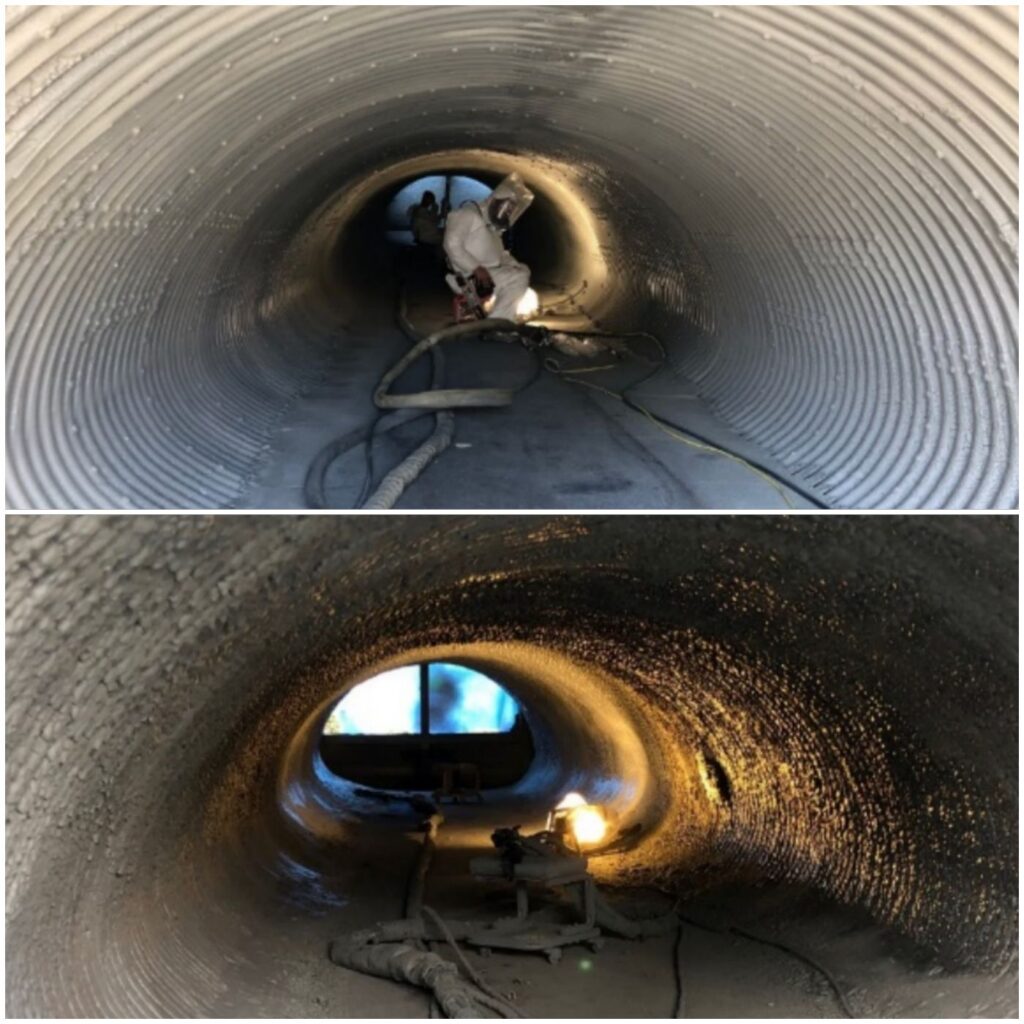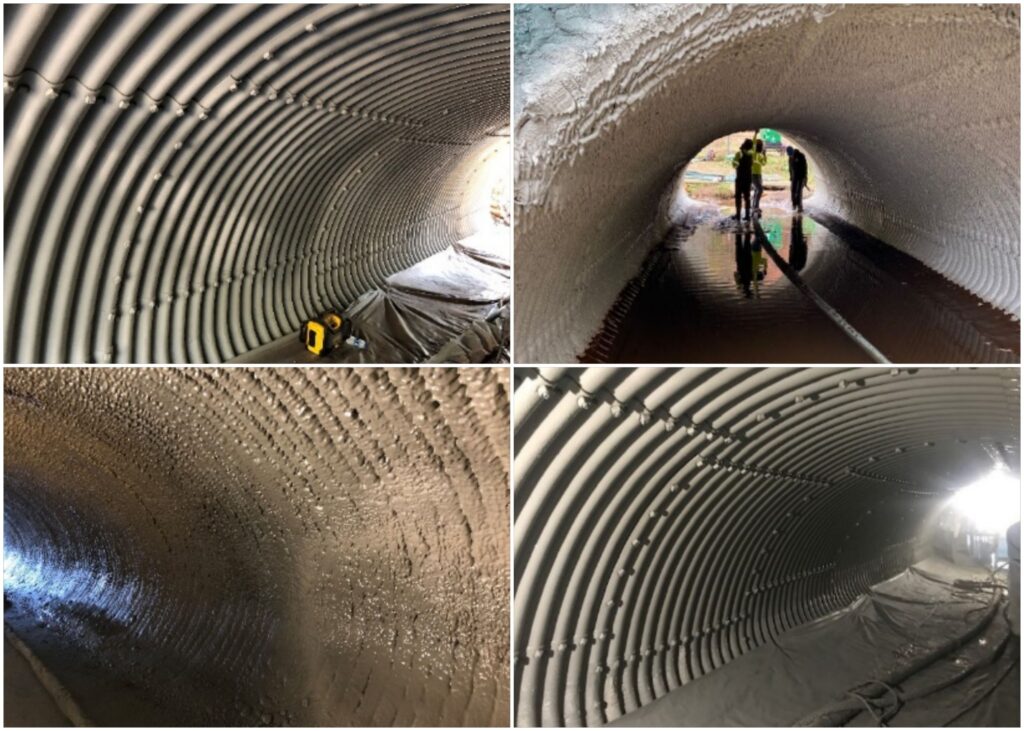
Culverts, those tunnels you see carrying water beneath a road, trail, or other obstructions, are often out of sight, out of mind. However, the condition of these structures can significantly impact our infrastructure and the environment. So, what do you do when a culvert begins to fail? Enter the world of trenchless culvert rehabilitation.
What Is a Culvert?
A culvert is a structure that allows water to flow under a road, railway, or similar obstruction. Typically made from corrugated steel pipe, reinforced concrete, or other materials, culverts are essential for preventing flooding and erosion by channeling stormwater and runoff from roads.
Why Do Culverts Fail?
Culverts can fail due to a variety of factors, which can be broadly categorized as follows:
- Corrosion: This typically occurs when elements like water, salt, and oxygen interact with the culvert material, causing it to degrade over time.
- Structural Damage: Culverts can suffer from structural damage caused by extreme weather events, soil movement, and heavy traffic loads. This can lead to cracks, holes, and eventual collapse.
- Blockages: These can occur due to the accumulation of debris, silt, or vegetation within the culvert. Blockages cause water backup, which can lead to increased pressure and potential structural damage.
Restoring Failing Culverts – The Trenchless Solution

There are innovative methods that can breathe new life into these essential structures without resorting to traditional, disruptive, and often expensive excavation methods. Trenchless culvert rehabilitation is a game-changer.
Think of trenchless culvert rehabilitation as minimally invasive surgery for our infrastructures. Just as medical professionals can fix bodily issues with minimal cutting, trenchless technologies allow us to rehabilitate culverts without tearing up the landscape. It’s an approach that’s as much about problem-solving as it is about respect for the surrounding environment.
In many cases, the traditional “dig-and-replace” method for culvert rehabilitation may not be feasible due to the location of the culvert or potential disruption to traffic. This is where trenchless technology comes into play. It offers a solution that causes minimal surface disruption, decreases rehabilitation time, and is generally more cost-effective.
Moreover, these techniques are not just for culverts that have already failed—they are an excellent preventative measure. Trenchless solutions can extend the life of culverts, preventing corrosion and costly failures down the line. It’s an ounce of prevention worth a pound of cure.
Culvert Lining: An Effective Trenchless Solution
Culvert lining is the process of creating a new, stable pipe/culvert within the existing structure. This can be achieved using a variety of methods, but one of the most effective is using a high-performance spray applied lining system.
This lining system can be for strictly anti-corrosion purposes or in the case of failed culverts it can be semi or fully structural.
For anti-corrosion systems the material is sprayed directly onto the interior of the culvert, creating a seamless, waterproof barrier.
For semi or fully structural systems this barrier not only protects the asset from future corrosion and damage but reinforces the culvert’s structure, essentially replacing it with a whole new culvert within the culvert or pipe within the pipe. For the semi and fully structural systems you aren’t bonding to the host pipe or culvert—you are essentially using them as a mold for the new spray applied structure.
Culvert lining helps prevent further deterioration of the culvert’s structure, stops leaks and seepage, and enhances its hydraulic efficiency. It essentially gives the culvert a new lease on life.
Culvert Repair/Rehabilitation vs. Replacement
The decision between culvert repair/rehabilitation and replacement can significantly impact both costs and project timeline:
- Replacement: This traditional method involves excavating the old culvert and installing a new one. While effective, it is often disruptive, time-consuming, and costly.
- Rehabilitation: This is a less intrusive approach that involves restoring the existing culvert to its original functionality. Techniques like trenchless rehabilitation can be much quicker, less disruptive, and more cost-effective.
Advantages of Trenchless Rehabilitation over Replacement
Trenchless rehabilitation offers several advantages over traditional replacement methods:
- Cost Savings and Reduced Traffic Disruption: Trenchless rehabilitation is often more cost-effective as it reduces the need for extensive excavation and road closure, thereby minimizing traffic disruption.
- Load Bearing Capability: Both Class III Semi-Structural and Class IV Fully Structural spray applied lining systems are available from Nukote restoring the original load-bearing capacity of the pipe/culvert.
- Environmental Benefits and Preservation of Existing Infrastructure: Trenchless methods cause less disturbance to the surrounding environment and allow for the preservation of the existing culvert structure.
- Faster Project Completion and Minimized Downtime: With trenchless rehabilitation, projects can often be completed more quickly, especially when robotics are utilized, minimizing downtime and disruption.
Two products leading the charge in this domain are NUKOTE ST® and NUKOTE PP300.
NUKOTE ST® is a rapid-set, spray-applied, aromatic pure polyurea elastomer. It is used for anti-corrosion systems or as part of a semi-structural (Class III) or fully structural (Class IV) lining system. Let’s break down its standout features:
- Superior chemical resistance
- Excellent adhesion to most substrates
- Excellent impact and abrasion resistance
- Resistance to hydrolysis and microbial attack
- NSF ANSI 61 Certified
NUKOTE PP300 is a two-component, rapid curing, spray applied polymeric product used in Class III and Class IV lining systems. There currently are no other spray applied products in the world with the ideal combination of ductility and load bearing capacity that Nukote PP 300 demonstrates.
Its defining features include:
- Excellent flexibility and ductility
- Superior tensile strength
- Excellent abrasion resistance
- NSF ANSI 61 certified
Case Study: Successful Culvert Rehabilitation
To understand the real-world effectiveness of trenchless rehabilitation and spray-applied lining systems, let’s look at a successful project conducted by IMC/Nukote Canada and their authorized installer Aqua Tech Solutions.

The Client: Regional Municipality of York, Canada
The Challenge: The client needed to structurally rehabilitate a fully deteriorated 2500 mm x 2100 mm ellipse CSP culvert located underneath a 4-lane road and bridge.
The Solution: IMC/Nukote created the required design and Aqua Tech installed the fully structural spray applied lining system. They utilized NUKOTE ST® and NUKOTE PP300, applied using cutting-edge Nukote Robotics. As there were species of wildlife in the area the solution installed had to be environmentally friendly and approved by Fisheries and Oceans Canada.
The Result: The project was successful, with the culvert efficiently and effectively rehabilitated, minimizing disruption to traffic flow on the highway above.
This case study demonstrates how the right products, a knowledgeable team, and trained experienced applicators can effectively restore failing infrastructure, reducing downtime and saving costs. For insight into another real-world application, check out this case study of VDOT Danville Culvert Rehabilitation that highlights another successful culvert rehabilitation project executed using NUKOTE ST® and NUKOTE PP300. The practical application of these products underscores their effectiveness and the impressive capabilities of the IMC/Nukote team in delivering tangible solutions.
Paving the Way for the Future of Culvert Rehabilitation
Culvert rehabilitation is an essential part of maintaining our infrastructure, and trenchless technologies like spray-applied lining systems offer efficient, cost-effective solutions. Whether you’re dealing with a single failing culvert or multiple assets, it’s worth exploring these modern, effective options.
As we look towards the future of culvert rehabilitation, the role of trenchless technologies and high-performance products like NUKOTE ST® and NUKOTE PP300 become even more significant. With these products and methods restoring the integrity of culverts and pipelines has never been easier.
Consider exploring these technologies for your next culvert rehabilitation project and the environment will thank you!
Partner with IMC/Nukote Canada Today!
The key to successful culvert rehabilitation lies not only in selecting the right method and materials but also in partnering with the right team. This is where IMC/Nukote Canada come in. We have the knowledge, experience, and innovative Nukote products to make vertical and underground asset rehabilitations a success.
Ready to take the first step towards efficient and cost-effective culvert rehabilitation, Contact us now!
 Karli Logan is the Owner and President of IMC Distributors which is the exclusive partner of Nukote Coating Systems in Canada. With a B.Sc and M.Sc, as well as a demonstrated history of working across a number of industries, she has a passion to drive significant gains and benefits for IMC’s clients.
Karli Logan is the Owner and President of IMC Distributors which is the exclusive partner of Nukote Coating Systems in Canada. With a B.Sc and M.Sc, as well as a demonstrated history of working across a number of industries, she has a passion to drive significant gains and benefits for IMC’s clients.